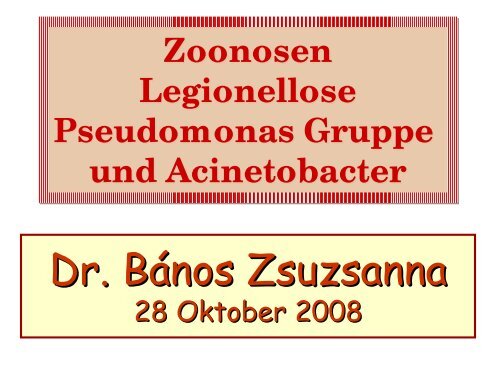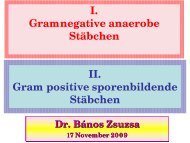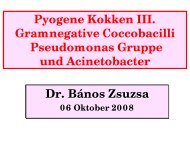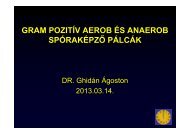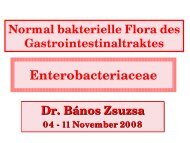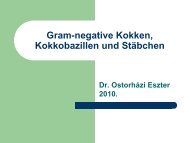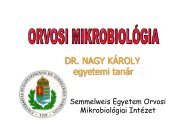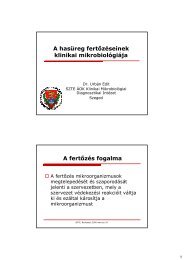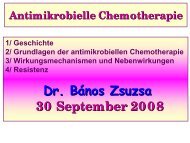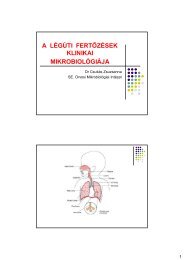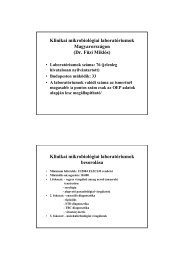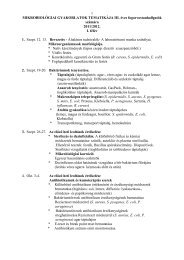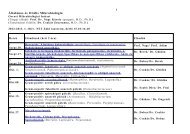Zoonosen Legionellose Pseudomonas Gruppeund Acinetobacter
Zoonosen Legionellose Pseudomonas Gruppeund Acinetobacter
Zoonosen Legionellose Pseudomonas Gruppeund Acinetobacter
Create successful ePaper yourself
Turn your PDF publications into a flip-book with our unique Google optimized e-Paper software.
<strong>Zoonosen</strong><br />
<strong>Legionellose</strong><br />
<strong>Pseudomonas</strong> Gruppe<br />
und <strong>Acinetobacter</strong><br />
Dr. Bános nos Zsuzsanna<br />
28 Oktober 2008
GRAMNEGATIVE STÄBCHEN<br />
AEROB<br />
Bordetella<br />
Brucella (Z)<br />
Francisella (Z)<br />
<strong>Pseudomonas</strong><br />
<strong>Acinetobacter</strong><br />
Legionella<br />
FAKULTATIV ANAEROB<br />
Haemophilus<br />
Pasteurella (Z)<br />
Familie:<br />
Enterobacteriaceae<br />
Vibrionaceae<br />
Cardiobacterium<br />
Eikenella<br />
Kingella<br />
Actinobacillus<br />
ANAEROB<br />
Bacteroides<br />
Prevotella<br />
Porphyromonas<br />
Fusobacterium<br />
MIKROAEROPHIL<br />
Campylobacter<br />
Helicobacter
<strong>Zoonosen</strong>: <strong>Zoonosen</strong>:<br />
Brucella,<br />
Francisella, Pasteurella und<br />
Pest<br />
1. Brucella<br />
www.lshtm.ac.uk/.../archives/images/bruce1.jpg<br />
Sir David Bruce (1855-1931)
Brucellae<br />
Morphologie:<br />
Gramnegative Coccobacilli<br />
Züchtung:<br />
Agar - Anreicherungsmedien<br />
(Serum, Glycerine)<br />
CO2<br />
21 Tage<br />
Resistent!
Description: Brucella spp. Colony Characteristics: - A. Fastidious, usually not<br />
visible at 24h. - B. Grows slowly on most standard laboratory media (e.g. sheep<br />
blood, chocolate and trypticase soy agars). Pinpoint, smooth, entire translucent,<br />
non-hemolytic at 48h<br />
staff.vbi.vt.edu/pathport/pathinfo_images/Bru...
Brucellae<br />
Pathogenese, Infektion, Krankheitsbilder<br />
B. melitensis Ziege Maltafieber<br />
B. abortus Rind Morbus Bang<br />
B. suis Schwein Schweine Brucellose<br />
Anthropozoonose Alle Brucellose<br />
„Febris undulans” RES!<br />
(undulierendes Fieber)<br />
- von erkrankten Tiere (Fleisch, Milch)<br />
- durch direkten Kontakt oder kontaminierte Lebensmittel<br />
- Invasion durch Hautlesionen oder Konjunktiva oder<br />
Schleimhaut in GI Trakt
Brucella - Infektionsquellen<br />
Medmicro
Medmicro<br />
Brucella – Eintrittspforten<br />
Figure 28-1 Portals of entry for Brucella species.
Medmicro<br />
Brucella – Verbreitung
Figure. Acute unilateral scrotal swelling<br />
in a 27-year-old man with brucellosis.<br />
www.medscape.com/.../art-iim441224.fig.jpg
Fig.13.36 Brucellosis. Arthritis of the<br />
left knee. This was accompanied by<br />
fever, malaise, generalized myalgia and<br />
depression.<br />
Fig. 13.37 Orchitis – B. abortus
Brucellosis - Diagnose
Brucellose<br />
Diagnose<br />
Kultur: min. 5 Tage<br />
Serologie<br />
Antikörpernachweis<br />
Rörchenagglutination (Wright)<br />
IgM Chromatographie<br />
ELISA<br />
Therapie:<br />
Doxycyclin, Rifampicin, Streptomycin<br />
Prophylaxe:<br />
Vorsichtsmassnahmen<br />
Behandlung/Vernichtung der kranke Tiere<br />
WHO – Bioterrorkategorie B!!!<br />
Brucella IgM<br />
www.kit.nl
<strong>Zoonosen</strong>: <strong>Zoonosen</strong>:<br />
Brucella,<br />
Francisella, Pasteurella und<br />
Pest<br />
2. Francisella<br />
Tulare Lake; California, USA
Francisella tularensis<br />
Morphologie:<br />
Gramnegative Stäbchen<br />
Kälteresistent<br />
Kultivierung verboten!<br />
Nur in speziellen Laboratorien<br />
WHO – Bioterrorkategorie A!!!<br />
Pathogenese, Infektion<br />
- von kranken Tiere<br />
- durch direkten Kontakt<br />
oder Inhalation oder per os oder via Ektoparasiten<br />
KEINE ÜBERTRAGUNG zwischen Menschen
Francisella tularensis<br />
Krankheitsbilder:<br />
TULARAEMIE<br />
Lymphknoten, kleine Granulomen<br />
+ Ulzeröse Läsionen<br />
+ Nekrose<br />
Primär Komplex<br />
kutano-, okulo-, tonsilloglanduläre, (sichtbar!)<br />
thorakale, abdominale - (nicht sichtbar!) Formen<br />
Generalisation – Granulomenbildung!<br />
Diagnose: Serologie<br />
Prophylaxe:<br />
Expositionsprophylaxe<br />
Therapie:<br />
Streptomycin, Doxycyclin,<br />
Ciprofloxacin
A reported case of<br />
exposure of a patient to<br />
a wild rabbit, which<br />
subsequently died,<br />
suggested that tularemia<br />
was the likely etiology<br />
staff.vbi.vt.edu/.../Ftularensis
Description: Cervical Lymphadenitis in a Patient With Pharyngeal Tularemia;<br />
Patient has marked swelling and fluctuant suppuration of several anterior<br />
cervical nodes. Infection was acquired by ingestion of contaminated food or<br />
water. Source: World Health Organization<br />
staff.vbi.vt.edu/.../Ftularensis
Description: Chest<br />
Radiograph of a Patient With<br />
Pulmonary Tularemia<br />
staff.vbi.vt.edu/.../Ftularensis<br />
Description: These Francisella<br />
tularensis colonies show characteristic<br />
opalescence on cysteine heart agar<br />
with sheep blood (cultured at 37 C for<br />
72 hours). Note: On cysteine heart<br />
agar, F tularensis colonies are<br />
characteristically opalescent and do<br />
not discolor the medium
<strong>Zoonosen</strong>: <strong>Zoonosen</strong>:<br />
Brucella,<br />
Francisella, Pasteurella und<br />
Pest<br />
3. Pasteurella<br />
upload.wikimedia.org/.../4/42/Louis_Pasteur.jpg<br />
Louis Pasteur (1822-1895)
Pasteurella multocida<br />
Morphologie:<br />
Gramnegative, kleine Stäbchen<br />
Kultur:<br />
Blut- und Kochblutagar<br />
Pathogenese:<br />
Durch Hunden und/oder Katzenbiss<br />
Bei Immunschwäche: Sepsis!<br />
Therapie: Chirurgie, Penicilline<br />
medecinepharmacie.univ-fcomte.fr
Pasteurella multocida<br />
Fig. 10.55 Animal bite.<br />
Infected wound of finger<br />
following bite of domestic<br />
cat. P. multocida was<br />
isolated from the wound.<br />
aapredbook.aappublications.org
aapredbook.aappublications.org<br />
Pasteurella<br />
multocida<br />
cellulitis<br />
secondary to<br />
multiple cat<br />
bites about the<br />
face of a oneyear-old<br />
child
<strong>Zoonosen</strong>: <strong>Zoonosen</strong>:<br />
Brucella,<br />
Francisella, Pasteurella und<br />
Pest<br />
4. Pest – Yersinia pestis<br />
1863 - 1943
Yersinia pestis Gattung: Enterobacteriaceae!<br />
Morphologie: Gramnegative Stäbchen – bipolare Färbung<br />
www.lonlygunmen.de<br />
Giemsafärbung<br />
www.mja.com.au
Yersinia pestis<br />
KULTIVIERUNG IST VERBOTEN<br />
Nur in speziellen Laboratorien<br />
WHO – Bioterrorkategorie A!!!<br />
www.idph.state.il.us, www2.cnrs.fr, ww.knowledgenews.net,
Pest - XIV. Jh.
Yersinia pestis<br />
VIRULENZFAKTOREN<br />
Kapsel – Protein!<br />
V Antigen (Protein) Antiphagozytär<br />
W Antigen = Endotoxin<br />
Extrazelluläre Substanzen<br />
- Plasminogen – Aktivator – Protein (Pla)<br />
Ausbreitung, fibrinolytisch<br />
- Mausletales Toxin
Yersinia pestis<br />
Pathogenese, Infektion:<br />
Infektionsquelle:<br />
Ratten (und andere Nagetieren)→ Ratten Vernichtung!!!<br />
Übertragung:<br />
direkt Kontakt,<br />
Biss des Rattenflohs<br />
Penetration: Haut
Yersinia pestis<br />
Medmicro<br />
Figure 29-4 Pathogenesis of<br />
Y. pestis in plague patients.
Yersinia pestis<br />
Krankheitsbilder:<br />
1)Bubonenpest<br />
(geschwollene Lymphknoten)<br />
2) Septicaemie → haemorrhagische Entzündung<br />
3) Lungenpest = Pneumonie ← direkt aerogen<br />
Übertragung zwischen Menschen<br />
(Tröpfcheninfektion → primär Lungenpest)!
Bubonenpest<br />
Fig. 13.55 Plague. Enlarged tender inguinal lymphnodes in a Vietnamese<br />
child with bubonic plague.<br />
Fig. 13.56 Advanced stage of inguinal lymphadenitis in bubonoc plague.<br />
The nodes have undergone suppuration and the lesion has drained<br />
spontaneously.<br />
By courtesy of Dr. J.R. Cantey
Septische Pest<br />
Necrosis of<br />
finger tips of<br />
septicemic<br />
plague.<br />
Cutaneous Hemorrhages in Plague. Source www.cdc.gov<br />
www.imcworldwide.org
Lungenpest<br />
www.imcworldwide.org
Yersinia pestis<br />
Diagnose<br />
Klinisch<br />
Direkter Nachweis - Mikroskopisch<br />
Serologie – Rörchenagglutination, IF<br />
Therapie:<br />
Doxycyclin, Streptomycin
Biologische Waffen - Zusammenfassung<br />
Biologische Waffen: Organismen, Toxine,<br />
Viren<br />
Ziel:<br />
• Individuen, ganze Populationen erkranken zu<br />
lassen oder gar auszurotten<br />
• Ökonomische schaden<br />
Biokriegsführung (militärische Konflikts)<br />
Bioterrorismus (ideologische Motive)<br />
Bioverbrechen (persönliche Ziele)
Biologische Waffen - Zusammenfassung<br />
Tab. XVI. 16.1. (Hahn)<br />
Kategorie: A, B, C<br />
Gefährlichste: A<br />
B. anthracis, C. botulinum, F. tularensis, Y. pestis<br />
Einfache Kultivierung<br />
Ausbreitung durch Atemwege<br />
Hohe Letalität<br />
Therapie?<br />
Plötzliche Auftreten<br />
Zahlreiche Fälle
<strong>Zoonosen</strong><br />
<strong>Legionellose</strong><br />
<strong>Pseudomonas</strong> Gruppe<br />
und <strong>Acinetobacter</strong><br />
Dr. Bános nos Zsuzsanna<br />
28 Oktober 2008
<strong>Legionellose</strong><br />
Legionella pneumophila<br />
Morphologie:<br />
Gramnegative Stäbchen<br />
Aerobe<br />
www.lf3.cuni.cz
Legionella
Legionella<br />
www.waterscan.co.yu
Legionella pneumophila<br />
Geissel,<br />
Fimbriae
mcb.berkeley.edu<br />
Legionella
Legionella pneumophila<br />
Blutagar<br />
Kultur:<br />
Spezielle Nährmedien!<br />
BCYE (Hefeextract, Aktivkohle)<br />
(pH=9; Temperatur 35°C; 3 Tage)<br />
BCYE
BCYE<br />
www.lf3.cuni.cz<br />
Legionella<br />
Kultur
Legionella<br />
Kultur<br />
www.contractlaboratory.com
medecinepharmacie.univ-fcomte.fr<br />
Legionella
Legionella pneumophila<br />
Pathogenese-1:<br />
Infektionsquelle, Vorkommen:<br />
ubiquiter<br />
(Klimaanlagen, Gewässern,<br />
feuchtes Boden, Biofilms)<br />
Übertragung:<br />
aerogen - Tröpfcheninfektion!
www.ratsteachmicro.com
www.eco-khlamx.com
Legionella pneumophila<br />
Pathogenese-2:<br />
Fakultativ intrazellulär!<br />
Im Wasser: Protozoon<br />
In Menschen:<br />
Leukozyten,<br />
Entzündungsreaktion,<br />
Proteasen, Phospholipasen<br />
www.lifespan.org
Legionella in<br />
Amoeba<br />
FIGURE 40-7<br />
Electron<br />
micrograph<br />
showing<br />
L. pneumophila<br />
serogroup 1 in the<br />
process of<br />
dividing (arrows)<br />
within a vesicle of<br />
an amoeba<br />
(Hartmanella<br />
veriformis) cell.
Pathogenic cycle of Legionella<br />
microbewiki.kenyon.edu
textbookofbacteriology.net/Legionella.jpeg
Legionella pneumophila<br />
Krankheitsbilder:<br />
<strong>Legionellose</strong><br />
1) Pneumonie → Legionärskrankheit<br />
2) Pontiac-Fieber (nichtpneumonisch)<br />
Diagnose:<br />
Erregernachweis – Biopsie! BAL: direkt IF<br />
Kultur<br />
Antigendetektion – Urine<br />
Antikörpernachweis – Serologie; ELISA<br />
Prophylaxe: Vermeidung legionellenhaltiger Aerosole<br />
Therapie:<br />
Erythromycin, Tetracyclin, Rifampicin, FQ
Fig. 2.29 Legionnaires’ disease. Chest radiograph showing extensive<br />
consolidation affecting parts of all lobes of the lungs.
Diagnose<br />
Fig. 2.28 Legionella pneumophila. Specimen from bronchial biopsy taken through<br />
fibreoptic bronchoscope in a patient with fulminant Legionnaires’s disease. The organism<br />
can be isolated on selective culture media or by guinea pig inoculation. By courtesy of Dr.<br />
S. Fischer-Hoch
Fig. 2.30 Legionnaires’ disease. Autospy specimen showing<br />
consolidation of upper and lower lobes of right lung.
<strong>Zoonosen</strong><br />
<strong>Legionellose</strong><br />
<strong>Pseudomonas</strong> Gruppe<br />
und <strong>Acinetobacter</strong><br />
Dr. Bános nos Zsuzsanna<br />
28 Oktober 2008
<strong>Pseudomonas</strong> Gruppe<br />
<strong>Pseudomonas</strong> P. aeruginosa P<br />
Burkholderia B. mallei P<br />
B. pseudomallei P<br />
B. cepacia<br />
Stenotrophomonas S. maltophilia<br />
(Xanthomonas)<br />
P = pathogen
<strong>Pseudomonas</strong> aeruginosa<br />
Morphologie und Kultur:<br />
Gramnegative Stäbchen 1-2 μm,<br />
Anspruchslos; Biofilmbildung!
<strong>Pseudomonas</strong> aeruginosa<br />
Pigmente:<br />
1. Pyocianin<br />
2. Fluorescein<br />
Haemolyse (β)
<strong>Pseudomonas</strong> aeruginosa<br />
SEHR RESISTENT !<br />
-Recht resistent gegenüber<br />
Hitze<br />
Licht<br />
Austrocknung<br />
Desinfektionsmittel<br />
Antibiotika
<strong>Pseudomonas</strong> aeruginosa<br />
ANTIGENE UND VIRULENZFAKTOREN:<br />
Adhäsion und Kolonisation<br />
- "0", "H", Pili/Fimbriae<br />
- Kapsel = Glycocalyx<br />
- Alginate slime = mukoid Exopolysaccharid Biofilmbildung<br />
Invasion, Penetration<br />
- Extrazelluläre Proteasen, Exoenzyme (viele!)<br />
- Cytotoxin = Leukocidin und Haemolysine<br />
-Pigmenten<br />
Dissemination<br />
- Exotoxin A – hemmt Proteinsynthese (EF2 – wie Diphtherie)<br />
- Exotoxin/Exoenzym S – bei Verbrennung; Nachweis im Blut<br />
- Endotoxin<br />
LD50 – bei Verbrennungswunde 30<br />
Normale Haut 10 8
Extrazelluläre Substanzen<br />
Pili/Fimbriae (Adherenz)<br />
Flagellum (Motilität) Kapsel;<br />
Alginate slime<br />
<strong>Pseudomonas</strong> aeruginosa – Struktur<br />
Medmicro
No single factor is<br />
decisive for virulence.<br />
www.ratsteachmicro.com
Hemmung von Proteinsynthese<br />
<strong>Pseudomonas</strong> aeruginosa<br />
Toxin-A Wirkungsmechanismus<br />
Inaktiv Molekül<br />
<strong>Pseudomonas</strong> aeruginosa – elmi
<strong>Pseudomonas</strong> aeruginosa<br />
Pathogenese, Infektion:<br />
Vorkommen:<br />
Boden, Wasser (Schwimmbad, Pools!), Abwässer<br />
Darmtrakt der Menschen<br />
Respirationstrakt: Tiere<br />
Infektionsquelle:<br />
Kranke, Keimträger<br />
Kontaminierte Gegenstände<br />
Lösungen (feuchtes Milieu!) Kunststoffe<br />
Übertragung: direkter, indirekter Kontakt
<strong>Pseudomonas</strong> aeruginosa<br />
Krankheitsbilder:<br />
Krankenhausinfektionen<br />
- Meningitis, Pneumonie (Respirator!)<br />
-Sepsis<br />
- Verbrennung! Haut, Wunden<br />
- Urogene Infektionen (Katheter),<br />
- Darminfektionen (!), Säuglinge<br />
- Otitis media, externa<br />
- Augen + Kontaktlinsen<br />
Zystische Fibrose (mukoide Stämme)
Fig. 10.2 <strong>Pseudomonas</strong> folliculitis. Papulopustuler rash over the<br />
buttocks and thights following use of a spa pool.
Fig. 13-6 Ecthyma gangrenosum. Necrotic round lesion on the buttock of a child<br />
with <strong>Pseudomonas</strong> septicaemia associated with immunodeficiency.
Fig. 12.46 Bacterial keratitis. Contact lens-associated keratitis due to<br />
<strong>Pseudomonas</strong> aeruginosa. By courtesy of Dr. A.N. Carlson
Thinned corneal stoma<br />
Diffuse<br />
infiltrate<br />
Edge of<br />
epithelium<br />
Fig. 12.47 Bacterial keratitis, in this case due to P. aeruginosa. An<br />
infiltrate is seen with corneal thinning. By courtesy of Mr. P.A. Hunter
Fig. 12.48 Bacterial keratitis. A massive inflammatory response in<br />
anterior uveitis leads to precipitation of the cells as pus in the anterior<br />
chamber. This is called hypopyon. By courtesy of Mr. S. Harding
Fig. 12.49 Bacterial keratitis. P. aeruginosa eye infection showing<br />
corneal ulceration and hypopyon formation in this rapidly progressive<br />
eye infection.
<strong>Pseudomonas</strong> aeruginosa<br />
Krankheitsbilder:<br />
Krankenhausinfektionen!<br />
Meningitis, Pneumonie (Respirator!)<br />
Sepsis<br />
Verbrennung! Haut, Wunden,<br />
Urogene Infektionen (Katheter),<br />
Darminfektionen (!), Säuglinge<br />
Otitis media, externa<br />
Augen + Kontaktlinsen<br />
Zystische Fibrose = Mukoviscidose<br />
(mukoide Stämme)
<strong>Pseudomonas</strong> aeruginosa
<strong>Pseudomonas</strong> aeruginosa<br />
Diagnose:<br />
Erregernachweis, Identifizierung, Oxidase +<br />
Therapie und Prophylaxe:<br />
Antibiogram!!!<br />
Aminoglykoside, Carbenicillin,<br />
antipseudomonas Cephalosporine, Fluoroquinolone<br />
Expositionsprophylaxe: Sauberkeit. Desinfektion.<br />
Aktive Immunisierung – in Zystischer Fibrose
Vakzine<br />
A conjugate vaccine in the final clinical phase is Aerugen®, the first and only<br />
vaccine for the prophylaxis of fatal <strong>Pseudomonas</strong> aeruginosa infections in<br />
cystic fibrosis patients. The polyvalent conjugate vaccine combines 8 prevalent<br />
P. aeruginosa serotypes and the bacterial exotoxin A. It is the first conjugate<br />
vaccine based on a lipopolysaccharide component.<br />
www.bernabiotech.com
Burkholderia mallei<br />
Krankheit: Malleus (Rotz) – Pferd, Esel<br />
Berufskrankheit<br />
Bioterrorkategorie B!<br />
microbewiki.kenyon.edu/images/3/39/Horse.jpg<br />
A horse with<br />
glanders and with<br />
positive mallein test<br />
www.vef.hr/vetarhiv/papers/68-5/alani2.jpg
Burkholderia pseudomallei<br />
Krankheit:<br />
Melioidose<br />
Pneumonie,<br />
Sepsis<br />
Subtropische<br />
und tropische<br />
Gebiete
B. pseudomallei<br />
www.co.collin.tx.us
www.asm.org<br />
B. pseudomallei<br />
B. pseudomallei on<br />
Ashdown's agar after<br />
incubation at 37°C in air for 3<br />
days
Burkholderia cepacia,<br />
Stenotrophomonas maltophilia<br />
Hospitalinfektionen<br />
www.cdc.gov/.../web%20images/01-0535-8t.jpg<br />
Figure 1. Electron micrographs showing expression of flagella by SMDP92.<br />
Stenotrophomonas maltophilia strains can have one (A) to several flagella<br />
(B,C). The flagella on these bacteria show a polar disposition. Bars, 0.5 µm
Figure 8. Ultrastructural<br />
analysis of<br />
Stenotrophomonas<br />
maltophilia adhering to<br />
plastic. (A) Scanning<br />
electron micrographs<br />
showing the tight adhesion<br />
of SMDP92 to the plastic<br />
surface. (B) Structures<br />
resembling flagella seem to<br />
be protruding and<br />
interconnecting bacteria<br />
(arrowheads) or connecting<br />
bacteria to the plastic<br />
(arrows). (C) In addition to<br />
the flagellalike filaments<br />
(arrowheads), high-power<br />
magnification shows the<br />
presence of thin fibrillar<br />
structures connecting<br />
bacteria to the abiotic<br />
surface. Bars: A 10 mm, B<br />
1 mm, C 2 mm.<br />
www.cdc.gov/.../web%20images/01-0535-8t.jpg
Stenotrophomonas maltophilia www.uni-ulm.de
Burkholderia sp.<br />
www.oregon.gov
B. cepacia<br />
www.uni-ulm.de
<strong>Acinetobacter</strong> spp.<br />
Morphologie:<br />
Gramnegative dimorph<br />
Stäbchen, Coccobacilli<br />
www.acinetobacter.org
<strong>Acinetobacter</strong> spp.<br />
Kultur:<br />
Agar, Blutagar<br />
Wichtig: Temperatur 40-44°C<br />
Nicht beweglich – „akinetisch”<br />
Pathogenese und Krankheitsbilder:<br />
wie bei <strong>Pseudomonas</strong> aeruginosa<br />
Krankenhausinfektionen<br />
Multiresistent!<br />
www.acinetobacter.org
Istanbul, 2006<br />
ENDE


